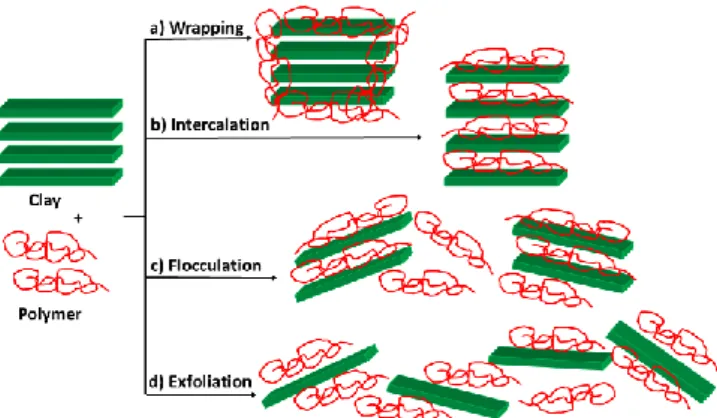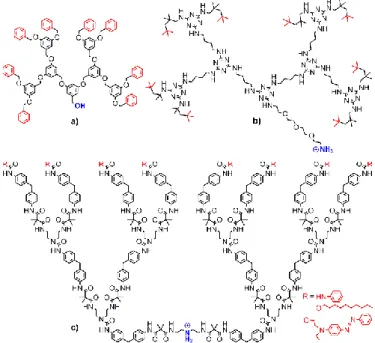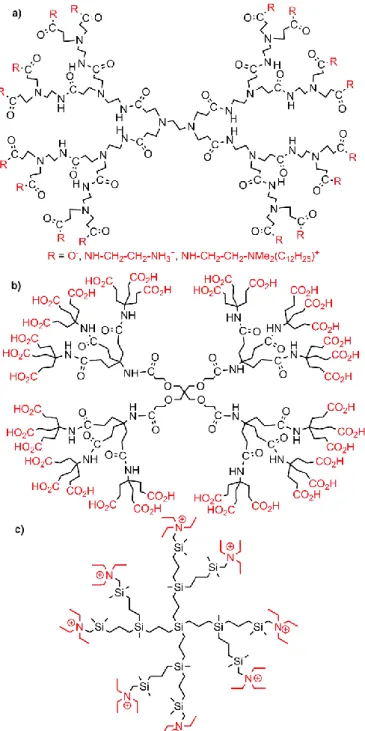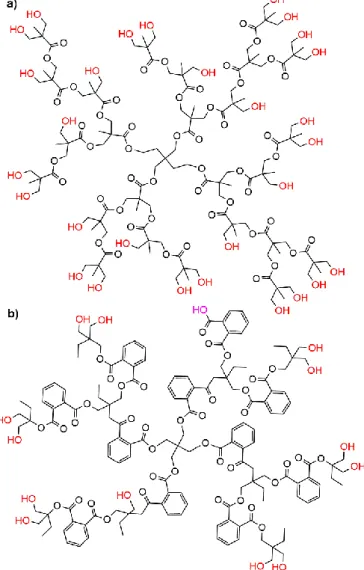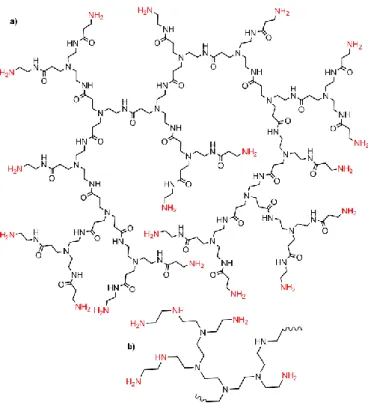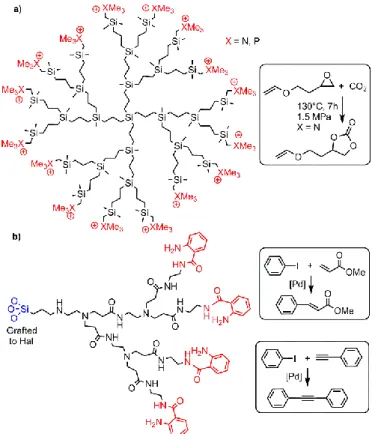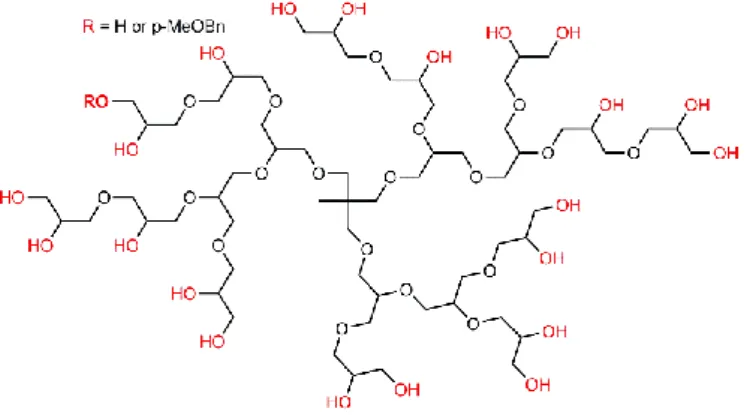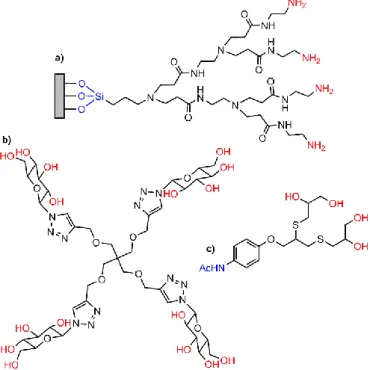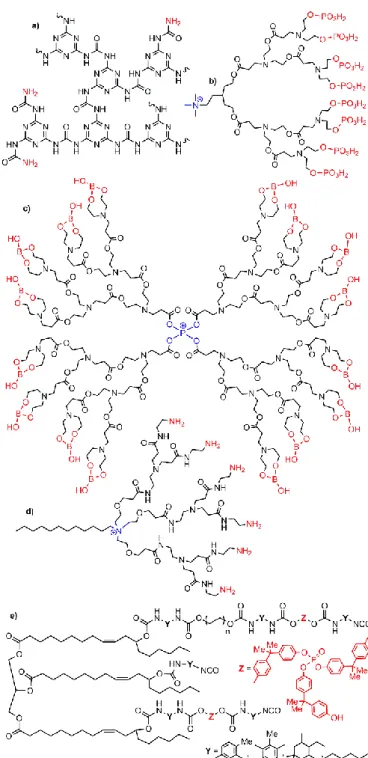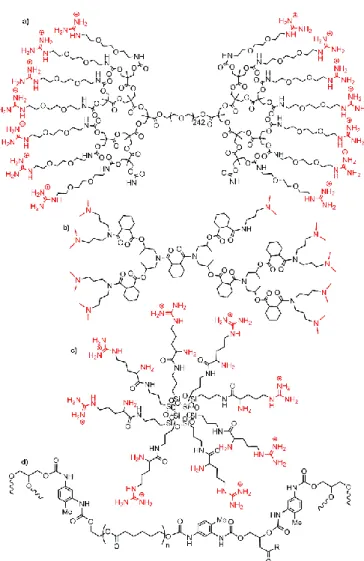HAL Id: hal-02330747
https://hal.archives-ouvertes.fr/hal-02330747
Submitted on 2 Nov 2020
HAL is a multi-disciplinary open access
archive for the deposit and dissemination of
sci-entific research documents, whether they are
pub-lished or not. The documents may come from
teaching and research institutions in France or
abroad, or from public or private research centers.
L’archive ouverte pluridisciplinaire HAL, est
destinée au dépôt et à la diffusion de documents
scientifiques de niveau recherche, publiés ou non,
émanant des établissements d’enseignement et de
recherche français ou étrangers, des laboratoires
publics ou privés.
Anne-Marie Caminade, Abdellah Beraa, Regis Laurent, Béatrice
Delavaux-Nicot, Mohamed Hajjaji
To cite this version:
Anne-Marie Caminade, Abdellah Beraa, Regis Laurent, Béatrice Delavaux-Nicot, Mohamed Hajjaji.
Dendrimers and hyper-branched polymers interacting with clays: fruitful associations for functional
materials. Journal of Materials Chemistry A, Royal Society of Chemistry, 2019, 7 (34),
pp.19634-19650. �10.1039/C9TA05718H�. �hal-02330747�
Journal of Materials Chemistry A
REVIEW
a.Laboratoire de Chimie de Coordination du CNRS, 205 route de Narbonne, BP 44099, F-31077 Toulouse Cedex 4, France.
b.
LCC-CNRS, Université de Toulouse, CNRS, Toulouse, France. c.
Laboratoire de Physico-chimie des Matériaux et Environnement, Unité Associée au CNRST (URAC 20), Faculté des Sciences Semlalia, Université Cadi Ayyad, B.P. 2390, Av. Pce My Abdellah, 40001, Marrakech, Morocco.
Received 00th January 20xx, Accepted 00th January 20xx
DOI: 10.1039/x0xx00000x
www.rsc.org/
Dendrimers and hyper-branched polymers interacting with clays:
fruitful associations for functional materials
Anne-Marie Caminade,*a,b Abdellah Beraa,a,b,c Régis Laurent,a,b Béatrice Delavaux-Nicot,a,b and Mohamed Hajjajic
The possibility to incorporate diverse chemical species inside clays, especially swelling clay minerals, is known since more than two millennia, but the first examples of man-made polymers interacting with clays only dates back to about 30 years. Dendrimers and hyper-branched polymers differ from classical polymers by their intrinsically 3-dimentional structure, and by their large number of reactive functional groups. The study of their interaction with clays/clay minerals is relatively recent. Besides the fundamental researches done on these kinds of organoclays, different potentialuses have already been investigated. In this review, we will present an overview of the studies dealing with the synthetic processes, and the characterization of the resulting dendrimers/hyper-branched polymers-clay minerals (nano)composites. A special attention will be focussed on the properties of these new hybrid smart materials, in different fields ranging from catalysis, trapping gases (in particular CO2 and H2), energy conversion and storage, flame retardants, biology (biosensors, hydrogels, drug delivery) and water treatment (wastewater and water-based drilling fluids).
1. Introduction
Clay is a fine-grained fraction of various soils and rocks. It is composed of clay minerals (phyllosilicates) and ancillary minerals (quartz, feldspar, carbonates, iron oxide/hydroxide, etc.). The framework of the clay minerals consists of stacked compact plans of oxygen anions and hydroxyls. Such a structure results in the formation of linked tetrahedral (T) and octahedral (O) sheets, which mainly comprise Si4+ and Al3+ ions, respectively. Elements such as Mg, and occasionally Fe, K, and Ca can be found in the structure. The combined sheets, denoted a layer, are separated from each other by interlayer spaces. Clay minerals are classified based on the amount of T and O per layer and the deficit charge/unit cell, among others. The clay minerals of the smectite group, such as montmorillonite, beidellite, saponite and stevensite, are T-O-T minerals, and their deficit of charge varied in the range of 0.2-0.6 per unit cell. Because of their nano-lamellar structure, the high cation exchange capacity and the interlayer expandability, these clay minerals are suitable materials for the synthesis of functional organoclays.1
Clay is one of the oldest materials used by Man, and one of the greenest and sustainable materials. The incorporation of different types of substances for modifying clay properties has
been discovered very early, in particular for the production of potteries in ancient Greece2 and China.3 For several millennia only ions or small-sized molecules have been incorporated in clays,4 leading to a range of uses in the paper, ceramic, paint, plastic, rubber, and cracking catalyst industries; clays have been used also as sealant, absorbent, cosmetics, personal care products, pharmaceuticals, and so on.5,6
During the XXth century, polymers have been incorporated in clays, or vice-versa (clays incorporated in polymers), depending on the relative concentration of each component. Depending also on the nature of the polymer and of the clay mineralogy, and the conditions and strategies used, different types of composites/nanocomposites can be obtained.7 In many cases, the interaction occurs by exchange of cations, because clay minerals are in general anionic species. The polymers can wrap clay particles (case a, Fig. 1), be intercalated inside the clay layers (case b), or induce the flocculation (case c) or the exfoliation (case d) of the clay.8,9 The last case affords remarkable improvements in the mechanical, thermal and barrier properties of the materials, leading to new applications for automotive, electric and food industries.10 The development of nanocomposites based on clay/polymer certainly represents one of the most dynamic research areas in polymer science and technology.11
Fig. 1. Schematic representation of possible interactions between polymers and clays.
Dendrimers12 are a very special class of macromolecules among all types of polymers. Indeed, they are constituted of monomers (as polymers), but they are always synthesized step-by-step, and not by polymerization reactions. Furthermore, contrarily to the most classical polymers, they are not linear but highly branched, with regular branches emanating from a central core. Each time the number of terminal functions is multiplied, a new generation is created. The branching points are most generally a nitrogen atom, but main group elements have been used too.13 Dendrimers are 3-dimensional macromolecules, decorated on their surface by a number of functions easily modified to afford the desired properties.14 Many examples of dendrimers used as catalysts, for advanced materials and for biology/nanomedicine have been proposed.15 A recent review has emphasized in particular their role for the elaboration of nanomaterials.16 A particular family of dendrimers are dendritic wedges,17 which are called also dendrons. Close analogues of dendrimers, synthesized by polymerization reactions do exist, and they are named hyper-branched polymers.18 Despite their architectural resemblance at first glance (Fig. 2), dendrimers and hyper-branched polymers are inherently different from each other.19
Fig. 2. Schematic representation of a hyper-branched polymer, a dendrimer
(generation 4), and a dendron (generation 4). Terminal functions are in red, the core of the dendron is represented as a blue square.
In this review, we will present an overview of the interactions of dendrimers and of hyper-branched polymers with clays. In view of all the work successfully carried out with polymers interacting with clays, the use of sophisticated, and eventually expensive hyper-branched structures for the same purpose might appear questionable. However, three main differences due to the branched architectures compared with the linear ones of most classical polymers can be anticipated, and found favourable for the interaction with clays. Firstly, even if a certain collapse can be observed for hyper-branched
structures in the solid state, the 3-dimensional structure is essentially preserved, contrarily to the case of linear polymers; such behaviour should be particularly suitable for an increased expansion of the interlayer of clays, inducing an increase of the absorption capacity of the composite. Secondly, the structure of dendrimers and dendrons is perfectly defined, and highly reproducible, due to their step-by-step synthesis; such property should be especially favourable to interact precisely and specifically with the organized layered structure of clays. Thirdly, hyper-branched structures have a large number of functional groups, very easily accessible, as they are located on their surface; such a large number of functions should facilitate the exchange with cations of the clays, and induce a stronger and more stable interaction, affording potentially reusable composites. These three main differences compared to classical linear polymers has fostered the research activity and the study of properties and uses of hyper-branched structures interacting with clays.
In this review, the synthetic processes and the characterization of the composites/nanocomposites based on hyperbranched structures and clays will be developed, but the focus will be mainly on the application properties, in different fields ranging from catalysis, trapping gases, for energy storage, as flame retardants, for biology and wastewater treatment.
2. Synthesis and characterization of the hybrid
clay materials
The first examples of interactions between clays and dendritic entities (dendrons, dendrimers, or hyper-branched polymers) were proposed at the beginning of this century. The seminal paper was a theoretical work concerning the effect of the polymer architecture (from linear to ten-armed stars) on their interaction with clays.20 The first practical attempts and most of the followings were carried out for purely fundamental reasons, and emphasis was first on the synthesis and on the characterization of the hybrid materials. Most of the properties have been studied later on, and will be displayed in part 3.
The techniques used for studying the interaction of polymers with clays have been applied also to dendrimers. This includes in particular techniques for characterizing the inter-layer spacing change, such as WAXD (wide angle X-ray diffraction), SAXS (small angle X-ray scattering), and XRD (X-ray diffraction). Other techniques such as TEM (transmission electron microscopy) or AFM (atomic force microscopy) have been used to visualize the spatial distribution of the phases, and structural defects. FTIR (Fourier transformed infrared) and solid state NMR (nuclear magnetic resonance) techniques have been proven effective for assessing the chemical interactions. Techniques for probing the thermal stability are particularly DSC (differential scanning calorimetry) and TGA (thermogravimetric analysis).21
The very first examples of dendrimers incorporated inside clays (two publications in 2003) concerned in fact dendrons. Polybenzyl ether dendrons of generations 3, 4, and 5 (Fig. 3a) were interacted with layered silicates constituting the clays, and pre-treated with alkyl ammonium. X-Ray diffraction (XRD) displays an increase of the interlayer distance from 31 to 45 Å with generation 3 dendron. No larger increase was observed with the higher generations.22 Four dendritic surfactants based on triazine dendrons (up to generation 3) (Fig. 3b), which can participate in a single cationic exchange (NH3+ at the core),
were interacted with bentonite, a smectite clay. It was shown that in these cases, only the tail of the dendrons was incorporated inside the clay structure.23
Polyurea/malonamide dendrons of generations 1 to 3, bearing decyl chain groups on the surface (Fig. 3c), were used for the intercalation inside sodium montmorillonite, a hydrated alumino-silicate clay. The spacing between the layers was increased from 12 Å in the montmorillonite to 40 Å after the incorporation of the generation 1 dendron, and 67 Å with the generation 2. The generation 3 dendrons afforded only the smallest distance (38 Å), which indicates that they are not fully incorporated.24 The same type of dendrons, but bearing phenyl groups instead of decyl chains as terminal functions, was also incorporated inside montmorillonite. In this case, the spacing was found to be 38, 77, and 115 Å with generations 1, 2, and 3, respectively.25 The same family of dendrons was also functionalized with azobenzene dyes as terminal functions of generations 1 to 3, with which a large spacing up to 126 Å was obtained. Mixing this nanocomposite with polyimide in N,N-dimethylacetamide induced exfoliation, and the resulting material was deposited onto ITO (indium-tin-oxide) glass. The electro-optical properties were measured.26,27 The comparison between the behaviour of these dendrons depending on the type of terminal functions has been carried out.28
Fig. 3. Types of generation 3 dendrons incorporated in clays. a) polybenzyl ether; b)
polytriazine; c) polyurea/malonamide.
2.2. The case of dendrimers
The main type of dendrimers, which is commercially available since a long time, is the PAMAM (polyamidoamide) dendrimer.29 Thus, it is not surprising that the very first type of true dendrimers studied for interacting with clays are the PAMAM dendrimers (Fig. 4a). Three papers the same year (2004) concerned the intercalation of generation 4.5 PAMAM dendrimers bearing 128 carboxyl terminal groups, in hydrotalcite, a hydroxycarbonate of magnesium and aluminium with lamellar structure as clay minerals.30 The composition (anionic charge of hydrotalcite to carboxylate of the dendrimer) varied from 1:1 to 1:8, the negatively charged dendrimers being used to replace the negative ions of the hydrotalcite. The association was characterized by FT-IR, XRD, SAXS (small-angle X-ray scattering), and elemental analyses. An increase of the hydrotalcite interlayer distance after the intercalation of the dendrimer was observed, from 3.20 to 25-28 Å.31 These nanocomposites were then adsorbed on a Langmuir monolayer of arachidic acid at the air/water interface.32 In a related example, the PAMAM dendrimers were used to protect silver nanoparticles, and this assembly was interacted with hydrotalcite. XRD data indicated the diffusion of the dendrimer-protected Ag nanoparticles into the hydrotalcite structure.33
More recent examples of the intercalation of positively charged PAMAM dendrimers with clays concerned Na montmorillonite (MMT). Generations 1 to 3 with quaternary ammonium salts as terminal functions were intercalated into MMT. XRD and transmission electron microscopy (TEM) indicated that the interlayer spacing was 28.3, 26.2, and 28.9 nm for the intercalation of generations 1, 2, and 3, respectively.34 Low generations (0 to 2) PAMAM dendrimers terminated with primary ammonium salts, reacted with MMT, afforded intercalated nanocomposites. Maximum organic content of generation 0 monolayer and generation 2 bilayer nanocomposites was ∼7% and ∼14% respectively.35 Other low generation PAMAM dendrimers, built from a cyclotriphosphazene core instead of a classical diamine, were also interacted with MMT, with the aim of producing flame-retardant nanocomposites, but no test was carried out to demonstrate this property.36
In another example, ternary composites consisting of MMT and amine-terminated PAMAM dendrimers (generations 3 to 5) used as encapsulating agent for lanthanum nanoparticles, were obtained. The thermal stability of the ternary composite was improved dramatically even with the addition of very small amounts of MMT clay, compared with the PAMAM/La composites.37
A few other types of dendrimers have been incorporated in MMT. Arborols with carboxylic acid terminal functions (Fig. 4b) were reacted with MMT, affording intercalated structures in almost all nanocomposites, except in case of the largest dendrimer (generation 2), where exfoliation was observed.38 Carbosilane dendrimers (generations 1 and 2) bearing quaternary ammonium terminal functions (Fig. 4c) were interacted with MMT clay. Experimental data and computer modelling based on Molecular Dynamics have shown the
non-linear dependence of the interlayer spacing on the amount of dendrimers used.39
Fig. 4. Types of dendrimers incorporated in clays. a) PAMAM; b) arborol; c) carbosilane.
2.3. The case of hyper-branched polymers
Hyper-branched polymers (HBP) are easier to synthesize than dendrimers (one step instead of several) and cheaper,40 but they have a lower degree of branching, and a lower control of the structure, compared to dendrimers.41 HBP have been more frequently used than dendrimers to interact with clays. One family predominates, i.e. hyper-branched aliphatic polyesters (HBPE, example shown in Fig. 5a), which were studied in most cases in interaction with montmorillonite (MMT). HBPE are
frequently prepared by condensation of 2,2-bis-hydroxymethyl propionic acid (bis-MPA), with a tetra- (or tri-) functional ethoxylated pentaerythritol-type core. In the first example, HBPE was reacted with MMT to prepare exfoliated composites, when small quantities of MMT (less than 20%) were used. 42,43 Analogous experiments carried out with 20 to 50% of MMT afforded intercalated MMT with a uniform layer spacing that increased with increasing HBPE size.44 The rheological behaviour of both exfoliated and intercalated montmorillonite clay composites was studied.45 In different conditions, significant exfoliation was only observed within 0– 5% wt/wt of MMT composition range,46 or under 9% wt.47 The confinement of the HBPE in the nanocomposite has been studied, using XRD, dielectric relaxation,48 and differential scanning calorimetry (DSC).49 The association HBPE/MMT has been used as additive in polylactic acid and polyamide-block-ether. An improvement of toughness was shown, potentially suitable for packaging applications.50
The HBPE has been also partly functionalized on the surface by a few epoxy groups, in combination with an epoxy resin and MMT, to obtain a nanocomposite. Strengthening and toughening of the epoxy resin was achieved using this process.51 The presence of the hyper-branched polyester gives the possibility to further modify the nanocomposites, in particular with polyurethane. For instance, reaction with methyl diphenyl diisocyanate produced a polyurethane (PU) network, in which the initial exfoliated state of the silicate layers was maintained.42,43,52 Several other papers have described the synthesis and characterization of HBPE/PU/MMT networks;53 a dramatic improvement in thermal stability,54 and in dynamic mechanical properties55 was observed. A few other types of modifications of the HBPE/MMT have been carried out. Partial functionalization with acrylic end-groups resulted in UV-curable hyper-branched nanocomposites, which led to better scratch resistance, and better adhesion to metal substrates.56 Cross-linking with hexakis(methoxymethyl)melamine induced an improvement in the thermal properties (increased stability in oxygen atmosphere), and an increase in the surface hardness, scratch resistance and flexibility of the material.57
Most of the above references concern the use of pristine montmorillonite (or intercalated with a small chemical species) used to interact with HBPE, but it is also possible to functionalize first the MMT with a polymer such as polypropylene,58 then to add the HBPE, or to add all the components together. The interactions among the different components significantly influenced the morphology, rheology, and thermomechanical properties of the nanocomposites.59
Besides MMT, a few examples of attapulgite (palygorskite), a type of natural nanofibrillar silicate clay mineral, have been published. Attapulgite was first functionalized with γ-aminopropyltriethoxysilane (APTES). Then it has been used via a melt polycondensation of 2, 2-bis(hydroxymethyl)propionic acid (bis-MPA) catalysed with p-toluenesulfonic acid (p-TSA), to afford hyper-branched aliphatic polyester covalently grafted to attapulgite.60 The alcohol groups were then
bromoacetylated, and used as macroinitiators for atom transfer radical polymerization (ATRP), affording star polymers on the attapulgite.61 Practically all the experiments using HBPE have been carried out with aliphatic polyester, but an aromatic polyester has been used too (Fig. 5b). The CTAB modified K10 clay (a type of montmorillonite) has been dispersed into the aromatic HBPE matrix, then isophorone diisocyanate has been reacted to afford a kind of PU-star polymer having a HBPE core, in which the clay is entrapped.62
Fig. 5. Types of hyper-branched polyesters (HBPE) incorporated in clays; a) aliphatic; b)
aromatic.
Several other structures concern hybrid hyper-branched polyesters, in which part of the structure is not constituted of esters. A hyper-branched polyether core based on triazine was modified with vegetable oil-modified linear polyester (an example in Fig. 6a). This hyper-branched polyester was interacted with 0–5 wt% nanoclay. In the nanocomposite with 5 wt% nanoclay (montmorillonite clay modified with 25–30 wt% octadecylamine), the thermal degradation temperature was improved by 37°C when compared with the pristine polyester system.63 A small HBPE having a quaternary ammonium at the core (an example in Fig. 6b) was used to modify sodium-montmorillonite, via ion-exchange reactions. Bilayer and pseudo-trilayer arrangements of hyper-branched
molecular chains, together with some exfoliated silicate layers were observed.64 These nanocomposites were then treated with vulcanized silicone rubber (RTV). The mechanical properties of RTV were improved as well as the elongation at break, and the thermal stability.65
Other hybrid polyesters were prepared by incorporating hyper-branched polyester polyol (HBP-G1) and chain extension was achieved by imide chain extender, affording hyper-branched polyurethane-urea-imide (an example in Fig. 6c). K-10 clay (montmorillonite) was first modified with CTAB or trimethylhexadecylphosphonium bromide (TBHPB) to expand the interlayer space, then APTMS (aminopropyl triethoxysilane) was covalently grafted to the clay. Hybrid materials were obtained by mixing the modified clay with the hyper-branched polyurethane-urea-imide.66 A hyper-branched polyesteramide polymer (an example in Fig. 6d) and its nanocomposites with montmorillonite (Na+−MMT) were studied both practically and by molecular dynamics simulations, to obtain a detailed picture of the behaviour in bulk and under confinement.67,68
A series of publications concerned hyper-branched polyesteramides (an example in Fig. 6e), in combination with cloisite clay (bentonite, essentially constituted of montmorillonite). This organoclay assembly was then added to polypropylene, with the aim of improving the surface properties and consequently the paint-ability of polypropylene, along with retaining mechanical properties.69 The same assembly was introduced into a bisphenol-A-based epoxy resin.70 It was used also to modify epoxy coatings. Significant enhancement of the epoxy coating corrosion resistance was observed.71
Hyper-branched polyurethane was synthesized by reacting a pre-polymer of urethane with glycerol (an example in Fig. 6f). A nanocomposite was obtained by reaction with MMT, affording a partially exfoliated and well-distributed structure, with two times improvement in the adhesive strength.72 An hyper-branched polyester-amine having amino groups as terminal functions (an example in Fig. 6g) was used as a toughening agent for epoxy resin in presence of montmorillonite organoclay. A significant improvement in toughness, and enhancement in thermal stability of epoxy/clay nanocomposites was observed.73
Besides HBPE and its derivatives, another type of hyper-branched polymer has been studied several times, i.e. the hyper-branched polyamidoamines (HB-PAMAM) (an example in Fig. 7a), which are less -defined analogues of the PAMAM dendrimers. In a first example, Cloisite Na+ was modified with HB-PAMAM, then reacted with polyurethane-based thermoset adhesive. The glass transition temperature of polyurethane was significantly increased (from 32 to 62°C).74 Different nanocomposites based on unmodified as well as treated (N-methylformamide) kaolinite, a layered aluminosilicate, and HB-PAMAM were formulated. Intercalation of HB-HB-PAMAM took place in pre-expanded kaolinite to give exfoliated nanocomposite. Unmodified kaolinite was also successfully intercalated with HB-PAMAM without pre-treatment to give a nanocomposite of intercalated type.75 HB-PAMAM has been
also interacted with clay nanosheets to produce nacre-like composites, which have been further stabilized using genipin as cross-linker. The fracture toughness was as high as 5.03 MJ m-3 and the mechanical strength was about 152.9 MPa.76
Fig. 6. Diverse types of mixed hyper-branched polyesters incorporated in clays. The amino ends of HB-PAMAM were modified with methyl methacrylate, styrene, and butyl methacrylate polymers, which were previously prepared via ATRP (atom transfer radical polymerization). These kinds of star-polymers display intercalation behaviour more than the exfoliation one, with both montmorillonite and laponite clays.77 Another type of
hyper-branched polymer analogue to a well-known family of dendrimer are hyper-branched polyethyleneimine (Fig. 7b), closely related to polypropyleneimine (PPI) dendrimers. Epoxy resin, and montmorillonite modified with the HB-polyethyleneimine, afforded a nanocomposite.78
Fig. 7. a) Example of branched PAMAM (HB-PAMAM); b) example of
hyper-branched polyethyleneimine.
A few other types of hyper-branched polymers have been used to modify different types of clays. A hyper-branched epoxy polymer prepared by an A2 + B3 polycondensation reaction
between in situ generated diglycidylether of bisphenol-A and triethanol amine (an example in Fig. 8a), was reacted with 3% weight bentonite modified with linear polyamidoamine polymer. The partially exfoliated structures display significant improvements of toughness, elongation at break, or adhesive strength compared to the pristine epoxy polymer.79
A multi-step process was used to produce a kind of star polymer, starting from an adamantane-based atom transfer radical initiator, subsequently used in the ATRP of methyl methacrylate (MMA) (Fig. 8b). This polymer was further used as a macroinitiator in ATRP reactions with 3-O-methacryloyl-1,2, 5,6-di-O-isopropylidene-α-D-glucofuranose. This glyco-polymer was used to form a nanocomposite with chitosan-modified nanofils of montmorillonite clay.80
An hyper-branched polymer containing primary amines as pendent groups, constituted of poly-2-aminoethyl methacrylamide hydrochloride block N-isopropylacrylamide (P(AEMA-b-NIPAM)) (an example schematized in Fig. 8c) was prepared using reversible-addition fragmentation chain transfer (RAFT) polymerization techniques. This temperature responsive hyper-branched polymer was used for solid−liquid separation of kaolinite clay suspension. Remarkable separation
of the fine particles at a low polymer dosage of 10 ppm was observed at 40°C.81
Fig. 8. a) Hyper-branched epoxy polymer; b) star polymer based on adamantane; c)
poly(2-aminoethyl methacrylamide hydrochloride block N-isopropylacrylamide).
3. Properties of the smart organoclays (hybrid
clay materials)
All the previous experiments have been carried out for fundamental purposes, but the use of clays in numerous areas is known since a long time.82,83 Clays modified with dendrimers/dendrons or hyper-branched polymers have been used mainly in 6 different fields, namely for catalysis, trapping gases, for energy conversion and storage, as flame retardants, in biology and for (waste) water treatment. All these fields will be described in the following paragraphs.
3.1. Hybrid materials for catalysis
The use of clays for catalysis is known since a long time,84 and a promising future for clays as catalysts has been announced early,85 thus it is not surprising that one of the earliest application of clays modified with dendrimers or hyper-branched polymers concerned catalysis. In the first example, a copolymer of chloromethylstyrene methylmethacrylate supported on montmorillonite was subsequently modified step-by-step with dendritic branches (dendrons) terminated with ammonium or phosphonium salts (Fig. 9). The catalytic phase-transfer activity of these systems was highly efficient for anions activation in nucleophilic substitution reactions.86
Fig. 9. Dendrons functionalized by ammonium or phosphonium salts for catalysing
nucleophilic substitution reactions.
Despite these interesting results, only a few other examples of dendrimer/clay nanocomposites used as catalysts have been presented. Layered nanocomposites consisting of montmorillonite and cationic carbosilane dendrimers having trimethyl ammonium or trimethylphosphonium terminal groups have been synthesized. Only the nanocomposite based on the third generation functionalized with trimethyl ammonium was used as catalysts in the cycloaddition of CO2
with allyl glycidyl ether (Fig. 10a).87
Fig. 10. a) Carbosilane dendrimer and montmorillonite used as catalysts for
cycloaddition of CO2; b) PAMAM dendron grafted to halloysite (Hal) for the
complexation of palladium and used in Heck and Sonogashira couplings (a large panel of reagents has been used, not only those shown here).
PAMAM dendrons synthesized from the surface of halloysite clay (natural kaoline-like clay) were functionalized with isatoic
anhydride, then complexed with palladium, not only on the surface, but also inside the structure. These nanocomposites were then used in a range of Sonogashira and Heck C-C couplings (Fig. 10b). Recyclability has been tested with up to 10 runs, and only a slight decrease in efficiency was observed, from 97% yield at run 1 to 82% at run 10 for Sonogashira couplings. The decrease was from 95% yield at run 1 to 80% at run 10 for Heck couplings. Different reagents have been used, not only those shown in Fig. 10b.88
3.2. Hybrid materials for trapping gases
Retention of gases by native clays and by clays modified with polymers has been reviewed early, in particular for pollutant gases, such as carbon dioxide.89 In the case of dendrimers and hyper-branched polymers, CO2 is also the most widely studied
type of gas, in connection with the problem of global warming. A series of papers concerned the use of montmorillonite clay functionalized by hyper-branched polymers, in particular polyesters (HBPE) of type shown in Fig. 5a. Expanded microporous materials with improved surface properties arose from both the inorganic support and organic moiety, suitable for the reversible retention of CO2.90
Several other papers have described the interaction between CO2 and HBPE/montmorillonite. The influence of the ratio
montmorillonite/HBPE, varying from 0.5, 1.0 to 3.0 wt.%, on the capture of CO2 was studied; 0.5–2.5 mmol/g organo-MMT
of CO2 could be retained, in correlation with the number of OH
groups of HBPE. Easy regeneration of the organoclay with release of CO2 could be achieved upon slight heating up to
100°C.91 However, HBPE contents exceeding 3 wt.% enhanced the hydrophobic character of the organic moiety, which aggregates into clusters, thus reducing the number of accessible sites to CO2. The major part of CO2 can be released
at temperature not exceeding 40–70°C or even at room temperature upon exposure to strong nitrogen stream.92 Another strategy consisted in using another type of polyol, a hyper-branched polyglycerol, prepared from glycidol (an example in Fig. 11), instead of HBPE. It was found also that the efficiency of the capture of CO2 increased with the number of
OH groups incorporated.93 Functionalization of the polyglycerol with a phenol enabled UV monitoring of the grafting to MMT. As in the case of HBPE, it was noted that aggregation into dense clusters reduced the number of OH groups accessible to CO2.94
Fig. 11. An example of hyperbranched polyglycerol.
The use of clay/dendrimers nanocomposites for the capture of CO2 has been carried out more recently than with
hyper-branched polymers, and concerns essentially the use of PAMAM dendrimers, as shown in Fig. 4a, with various types of clays.
The loading of PAMAM dendrimers (generation 4 with either ammonium or carboxylate terminal functions) depended on the surface area of the clays, and was in the order laponite > hydrotalcite > sericite. The capacity of CO2 adsorption on
organoclays laponite and sericite loaded with PAMAM dendrimers increased with the amount of loaded dendrimers, but only in the case of ammonium terminal functions.95 On the contrary, carboxylate-terminated dendrimer loaded on hydrotalcite clay reduced the CO2 adsorption in comparison
with pristine clay.96 These cation and anion-exchange organoclays, loaded with PAMAM dendrimers were hybridized with 2,2,6,6-tetramethylpiperidine-1-oxyl radical oxidized cellulose nanofibers (TOCNF). Thin films were prepared from these organoclay hybrids and were used for studying the adsorption of CO2, which increased with an increasing amount
of organoclays (functionalized with ammonium dendrimers) in the thin films.97 PAMAM dendrons from generations 1 to 7 were constructed step by step on the surface of ethylenediamine propyl-functionalized magnesium phyllosilicate lamellas (talc, a clay mineral) (Fig. 12a). Growth of the dendrons induced an increase in the interlamellar space and disorganization of lamella packing. An increase in the absorption capacity of CO2 was observed up to G5, probably
due to an increase in the number of ammonium groups, and then a decrease was observed up to G7, probably due to the
steric hindrance.98 Besides these large dendrimers and dendrons, a very small dendrimer (G0) based on a
tetraglucosylated pentaerythritol (Fig. 12b) has been used for the functionalization of bentonite and montmorillonite clays, and for the capture of CO2, via physical interaction with the OH
groups of the dendrimer.99
Besides CO2, a few other gases have been tentatively trapped
by clays modified with dendritic structures. Ammonia is harmful to humans, even in very small quantities in the air, thus considerable R&D efforts have been made for controlling the NH3 emission. PAMAM carboxylate–loaded hydrotalcite
clay was used for studying the adsorption of NH3. An increase
in adsorption capacity for NH3 with increasing the loading of
dendrimer was observed. The formation of carbamate species was confirmed by solid-state 13C NMR using isotope-enriched
13
CO2.100 In an analogous experiment, the thin films of
hydrotalcite organoclay (PAMAM carboxylate)-TOCNF cellulose nanofibers were found useful for the trapping of NH3. Thus,
the CO2 molecules are preferably captured in films
incorporating the cationic dendrimers, and the NH3 molecules
are preferably captured in films incorporating the anionic dendrimers.97
Hydrogen storage is a major issue to be addressed as an alternative for clean technologies energy sources. A very small dendron (Fig. 12c) intercalated in montmorillonite was further
loaded with copper, which has a good affinity for hydrogen. The resulting metal organoclay was then used for the trapping of H2. Low desorption heats were measured and almost
complete release of H2 was observed up to 80°C.101 Hydrogen
has been trapped also in montmorillonite incorporating HBPE and Cu and Pd nanoparticles. Hydrogen retention appears to involve mainly physical interactions as supported by easy gas release in the range 20-75°C.102,103 Other examples concerning energy will be presented in part 3.3.
Fig. 12. Small dendrimer and dendrons used in clays for trapping gases (a and b: for
CO2, c: for H2).
Besides trapping gases, modified clays can be used as gas barrier. Nanocomposites obtained from polyurethane grafted to the surface of hyper-branched polyesters, and interacting with cloisite, were used for studying the permeation of helium gas. High gas barrier properties were observed, in particular with the higher generation HBPE, in the presence of clays.104
3.3. Hybrid materials for energy conversion and storage
The prominent role of nanomaterials for energy conversion and storage has been recently emphasized, in particular for solar cells, thermoelectrics, lithium ion batteries, supercapacitors, and hydrogen storage systems.105 Examples of attempted energy storage with hybrid clay materials have been illustrated in the previous paragraph (part 3.2), concerning the storage of hydrogen.101-103 Diverse other examples related to energy storage concern the elaboration of batteries and of solar cells. A hyper-branched polyurethane (structure in Fig. 6f), in combination with montmorillonite afforded nanocomposite gel electrolytes, for application in Li-ion batteries. Ionic conductivity increased with the increase of clay loading, and improvement of electrochemical properties was observed.106 Hyper-branched chloromethyl styrene polymers (an example in Fig. 13) were obtained by ATRP.107 Related hyper-branched polymers were obtained by
combination of chloromethyl styrene with styrene and methacrylate, in the presence of montmorillonite. Some of these samples behaved as semiconductor materials, for further applications as dielectric materials.108
Fig. 13. Example of small hyper-branched chloromethyl styrene polymer.
The PAMAM dendrons elaborated from the surface of talc lamellas (Fig. 12a), from generation 1 to generation 7,98 were used as additives in a composite gel electrolyte, with polyiodides intercalated, for dye-sensitized solar cells. These samples had higher Jsc (short-circuit current density), and
photoconversion efficiency approaching the values of the reference cells containing liquid.109 A related paper focussed on the 5th generation PAMAM dendron. These solar cells maintained 95% of their initial efficiency under light-soaking at 1 Sun for about 1000 h. These cells with a quasi-solid electrolyte showed up to 5% higher efficiency than those with a liquid electrolyte,110 showing the potential of these devices for photovoltaics.
3.4. Hybrid materials as flame retardants
The objective of developing highly effective, “green” (no emission of halogen) flame retardants has boosted researches into novel technologies. A review concerning polymers/clays nanocomposites used as flame retardants has been published.111 All the examples of hyper-branched polymers and clays composites used as flame retardants concern montmorillonite as the clay component.
In a first example, urea and 2,4,6-trichloro-1,3,5-triazine were mixed to produce a hyper-branched polyamidoamine (an example in Fig. 14a), which was utilized to swell montmorillonite organo-nanoclay. The properties of the nanocomposites were tested by measurement of limiting oxygen index (LOI) value, and by measurement of the flame retardancy. A dramatic enhancement of thermostability and of flame retardancy was observed.112
Hyper-branched polymers synthesized in situ by polymerization of the monomer N,N-dihydroxyl-3-aminomethyl propionate in the presence of MMT, were finally functionalized with phosphoric acid on the surface (Fig. 14b). This organo-montmorillonite was used to prepare natural rubber composites. Natural rubber is easily flammable, as confirmed by a very low Limiting Oxygen Index (LOI) value (16%). By adding 5-20 phr (phr = parts per hundred of rubber) of hyper-branched polymers/MMT to pure natural rubber, the
LOI value increased to 25.5%. The fire in this case was very small, compared to that of natural rubber.113
Analogous hyper-branched polymers, have been built in the presence of montmorillonite from a phosphonium core, using the same monomer (N,N-dihydroxyl-3-aminomethyl propionate) and functionalized on the surface by boric acid (a possible structure is shown in Fig. 14c). These composites were built with the aim to enhance the flame retardancy properties.114 The flame retardancy of these nanocomposites in the presence of ethylene-propylene-diene monomer (a synthetic rubber) was improved, and the flammability was significantly reduced, as well as the toxicity of the smoke.115 The same type of experiment was carried out in the presence of natural rubber. In this case also, the flammability parameters, such as heat release rate, smoke evolution area, and carbon monoxide concentration, were obviously reduced.116
Fig. 14. Five types of hyper-branched polymers (shown as perfect structures for cases
b-d) being flame retardants when associated with montmorillonite.
Another type of hyper-branched polymer built from an ammonium core was synthesized using ethylenediamine and methyl acrylate, affording PAMAM dendron-like compounds (Fig. 14d), in the presence of montmorillonite. These clay-nanocomposites were used in the preparation of natural rubber composites. The flame retardancy was measured by the horizontal burning time, which increased by about 69%, from ca 130 s to ca 220 s.117 Hyper-branched polyamido amines (HPAMAMs) (Fig. 7a) have been assembled with clay nanosheets to produce films that have good mechanical performance, and are intrinsically blue fluorescent. Upon burning these films retained their original shape except that
they turned black, and the residue material showed good fire resistance.118
Hyper-branched (HB) polyurethanes were prepared by reacting castor oil, polyethylene glycol, and different diisocyanates with phosphorous containing triol, tris bisphenol-A mono phosphate (Fig. 14e). The HB polyurethane was used in combination with MMT to form films for coating surfaces. The resulting nano-clay composites have higher mechanical properties, LOI and char values, compared to the neat polymers.119
3.5. Hybrid materials in biology
The use of clay minerals for curative and protective purposes is as old as the earliest days of civilization.120 Thus it is not surprising that the pharmaceutical and biological applications of clays and clays composites with polymers, in particular for drug delivery, have been already reviewed.121 A recent review has emphasized the use of biopolymers such as chitosan (a polysaccharide).122
An early example using dendritic compounds concerned a very small proportion (0.4 % by wt.) of dendron units decorated with multiple guanidinium ion on the periphery, linked to both termini of a long, hydrophilic PEG spacer (Fig. 15a).They were mixed with water and clay (2–3 % by wt.), to quickly form a transparent hydrogel. This hydrogel has exceptionally great mechanical strength, and rapidly and completely self-heals when damaged. Interestingly, it preserves the biological activity of proteins, as illustrated by the catalytic activity of myoglobin for the oxidation of o-phenylenediamine with H2O2.123
Several authors have proposed the use of PAMAM dendrimers (Fig. 4a) and clays for several biological purposes. An amperometric glucose biosensor was elaborated from the fourth generation PAMAM dendrimers with OH terminal groups, incorporating montmorillonite clay clusters and platinum nanoparticles. This material was used for the immobilization of glucose oxidase on a glassy carbon electrode. The detection limit was 4 μM with a signal to noise ratio of 3.124 A related work was carried out with the second generation PAMAM dendrimer, MMT, and poly(vinyl) alcohol (PVA) as an auxiliary polymer, this assembly being deposited on glassy carbon electrode surface, and finally used for the immobilization of pyranose oxidases. This amperometric enzyme biosensor was used for the detection of glucose, even when included in a soft drink cola.125
Another example of electrochemical detection concerned poly Ɛ-caprolactone-chitosan nanofibrous materials including PAMAM dendrimers modified montmorillonite, and used for electrochemical cytosensing. Low generation PAMAM (generation zero with ammonium terminal functions) were used to achieve more hydrophilic surfaces and multi-point attachment of biomolecules, such as RGD (a bioactive peptide used for triggering cell adhesion). Adhesion of U87-MG (human brain tumour) and HaCaT (human skin immortal keratinocyte) cell lines was followed using electrochemical techniques and fluorescence microscopy.126
A second domain connected to biology, and studied several times with the hybrid materials concerns anti-bacterial properties. Two types of hyper-branched polymers (polyethyleneimine, Fig. 7b, and the aliphatic polyestheramide in Fig. 15b) have been used with montmorillonite to produce nanocomposites, upon photopolymerization of an acrylic matrix. The antimicrobial activity of these nanocomposites against two bacteria (Bacillus subtilis and Pseudomonas
aeruginosa) was tested, and inhibition of the adhesion of the
two bacteria was observed.127 Mixing hyper-branched PAMAM (Fig. 7a), a synthetic layer clay (ADDEZ 128), and copper ions (Cu2+) produced a multifunctional nacre-like hybrid film. These hybrid films showed excellent inhibition on the bacterial growth against S. aureus, due to both Cu2+ and positively charged HB-PAMAM.128 A small peptide (L-Arginine) dendrimer positively charged, based on a polyhedral oligomeric silsesquioxane (POSS) core (Fig. 15c) was used in combination with the negatively charged sodium polyacrylate entwined clay nanosheets, to produce a hybrid supramolecular hydrogel. Good biocompatibility and outstanding anti-biofouling property were observed with the hydrogel. However, the tests were carried out with MC3T3 cells (osteoblast precursor cell line derived from a mouse), and not with films of bacteria.129 Beside, the biodegradability of some hyper-branched polymer/nanoclay assemblies towards bacteria was tested. A diglycidyl ether bisphenol-S epoxy resin was modified by incorporating hyper-branched polyurethane (an example in Fig. 15d), then nanoclay (MMT) was added. The biodegradability of these nanocomposites was tested with
Pseudomonas aeruginosa bacterial strain; significant degradation was observed after 30 days of inoculation.130 Another biological use concerned drug delivery. A recent review has emphasized the role of modified halloysite clay nanotubes for biological and medical applications.131 Halloysite nanotubes have been functionalized first with 3-aminopropyltrimethoxysilane, then with suberic acid bis N-hydroxysuccinimide ester, and finally with PAMAM dendrimers (Fig. 4a) of generation 1. These nanotubes were then used as carriers of three different types of drugs, chlorogenic acid, ibuprofen and salicylic acid. High adsorption capacity for the drugs studied (123.16 mg/g for chlorogenic acid; 182.72 mg/g for ibuprofen; 39.52 mg/g for salicylic acid) were measured. The release rate of chlorogenic and salicylic acid decreased, while the release profile of ibuprofen was similar to that of 3-aminopropyltrimethoxysilane functionalized nanotubes. The toxicity of the functionalized nanotubes was assessed towards cultures of two living organisms, Acutodesmus acuminatus (algae) and Daphnia magna (planktonic crustacean). No influence of the material studied was observed.132
Fig. 15. Examples of dendrimers and hyper-branched polymers combined with clays,
and used for biological purposes.
3.6. Hybrid materials for water treatment
Undoubtedly, the importance of water quality preservation and its decontamination are essential for humans. Unfortunately, the quality of water resources is deteriorating day by day due to their continuous contamination by undesirable chemical species. Thus it is of utmost importance to find adsorbents, especially low-cost adsorbents, for the removal of pollutants from wastewater.133 In this perspective, modified clays appear as perfectly suitable.134 In particular clays modified with polymers are considered as adsorbents of the future for water treatment.135 Diverse examples report the use of dendrimers and hyper-branched polymers for such purpose. The first one concerned PAMAM dendrimers (Fig. 4a, ammonium terminal functions) interacting with montmorillonite (MMT). These nanocomposites were used for organic wastes adsorption, to remove organic content from aqueous solutions, in particular toluene and xylene. The dendrimer/clay nanocomposite was more efficient than the corresponding PEO/clay nanocomposite.136 In another example, PAMAM dendrimers and MMT, in addition to glucose-cored poly(aryl ether) dendrons, produced hydrogels. They were used for adsorbing PAH pollutants (polycyclic aromatic hydrocarbons, such as pyrene, phenanthrene, and
naphthol) from water with an average efficiency of 95%.137 Magnetite nanoparticles immobilized into PAMAM)/MMT hybrids exhibited pronounced sorption efficiencies for NH4+
(96%) and NO3− (83%), and a progressive degradation
efficiency toward the dye xylenol-orange (~85% mineralization). Interestingly, these nanocomposites could be reused for removal of various water-pollutants in seven cycles with an average efficiency of 95%.138
Besides MMT, halloysite nanotubes have been functionalized with PAMAM dendrons, built from the surface of these nanotubes, as shown in Fig. 12a. The third generation with amine terminal groups has been used for the adsorption of diverse dyes such as C.I. Acid Red 1 (5-(acetylamino)-4-hydroxy-3-(phenylazo)-2,7-Naphthalenedisulfonic acid, disodium salt) and C.I. Acid Red 42 (2-Naphthalenesulfonicacid, 6-amino-4-hydroxy-5-[[2-(phenylsulfonyl)phenyl]azo]-, monosodium salt). The maximum removal efficiencies were 93–94% at pH 3.139 The same type of experiment was carried out for the adsorption of cadmium and lead in six different water samples (seawater, lake water, river water, stream water, mine water and tap water). The results were analysed by high resolution continuum source graphite furnace atomic absorption spectrometry.140 Generation 1 PAMAM dendrons functionalizing halloysite nanotubes have been incorporated in reverse osmosis thin film nanocomposite (TFN) membranes, as well as other types of functionalized nanotubes. Membrane selectivity and permeate flux were evaluated in cross-flow reverse osmosis desalination experiments, using a synthetic brackish water. Considering the water flux, salt rejection and leachability of the nanotubes, TFN membranes with the first generation PAMAM dendron were among the best synthesized membranes.141 Another example of membrane concerned polyphenylsulfone and a montmorillonite clay modified with a hyper-branched epoxy (an example in Fig. 8a). The performance of the prepared membranes was investigated, showing that the water permeability, salt rejection, and antifouling resistance of membranes were improved significantly.142
Phosphorhydrazone dendrimers, functionalized with ammonium terminal functions,143 (Fig. 16) have been incorporated in different types of clays, for trapping pollutants commonly found in water in Morocco, such as chromium144 and methylene blue.145 In a first example, generations 1 (Fig. 16) and 2 were reacted with montmorillonite. Intercalated nanocomposites were formed with the first generation, whereas a mixture of intercalated and exfoliated nanocomposites was obtained with the second generation. The kinetics of the adsorption of chromate on both nanocomposites was studied. The maximum uptake amounts of chromate were in the range 23–38 mg/g in both cases.146 The same dendrimers were used with stevensite- or montmorillonite-rich clays. The resulting nanocomposites (exfoliated or intercalated as previously) were used for trapping methylene blue. The thermodynamic data indicated that methylene blue adsorbed spontaneously and that its uptake seemed to occur by chemisorption for
montmorillonite-based organoclays, and by physisorption for stevensite-based organoclays.147 Stevensite-rich clay, modified by the same dendrimers, was also used to adsorb chromate. Chromate adsorption took place at the edges and at the free surfaces of stevensite.148
Fig. 16. First generation water-soluble phosphorhydrazone dendrimer, used for
trapping pollutants.
Other examples about decontamination concern cases in which the pollutant is the clay itself, either contaminated with another pollutant or not. Water solutions of PAMAM dendrimers (Fig. 4a, generation 1 with either COO- or NH2
terminal functions, and generation 4 with NH2 terminal
functions) were passed through a fixed-bed column setup containing a lead-loaded soil bed (sand or clay). Generation 1 dendrimers were more effective than generation 4, whereas the effect of terminal groups was minimal. Up to 92% removal of lead was achieved, but the removal was more effective for sandy soil than for clay soil.149
Water-based drilling fluids with properties approaching that of oil-based drilling fluids are highly desirable for the oil and gas industry, but hydration and dispersion of reactive shales, which contain a significant amount of smectite clays (bentonite, montmorillonite, etc.), is a major problem. Amine-terminated PAMAM dendrimers have been proposed as potential shale stabilizers. A new water-based drilling fluid exhibiting excellent inhibitive properties was obtained, based on generation zero PAMAM as shale swelling inhibitor, which intercalated into the interlayer space. Generation five PAMAM has properties as shale dispersion inhibitor.150 The dendrimers expel the water molecules out of the interlayer, contributing to the suppression of clay swelling and dispersion.151 The same type of experiment was carried out with hyper-branched polyglycerols (HPG, Fig. 11). The clay inhibitive properties of HPG were evaluated by different test methods including bentonite inhibition test, and cuttings recovery. It was shown that HPG was able to inhibit, in conjunction with KCl, the dispersion and disintegration of clay cuttings, affording an
environmental friendly alternative to oil-based drilling fluids.152 The hyper-branched polyglycerols were partially hydrophobized by grafting some alkyl chains as terminal functions, using dodecyl tetradecyl glycidyl ether. In association with KCl, these hydrophobized HPG showed a superior performance in comparison with unmodified HPG, as clay reactivity inhibitors. Hydrophobized HPG minimized the shale-water interactions and removed water molecules present in the clay galleries, and caused obstruction of the clay minerals pore throats.153
4. Conclusions
This review is the first one dedicated to the interaction of dendrimers/dendrons and hyper-branched polymers with clays, even if a lot of papers have already been published in this field, which begun in 2003. Fundamental knowledges have been gained at the beginning, in particular using dendrimers and dendrons, thanks to their perfectly defined structure, with precise dimensions and shape. This field of research moved progressively towards applications of these hybrid nanocomposites, but nowadays, hyper-branched polymers are used more frequently than dendrimers and dendrons. This is mainly due to the high cost of dendrimers, synthesized by multi-step processes, compared to the low cost of hyper-branched polymers, generally synthesized in one step. Regarding the interactions between the dendrimers or hyper-branched polymers and clays, mainly montmorillonite, the studies showed that the organic species could be inserted within the interlayer spaces, and their adsorption occurred by cation exchange. As a consequence of the adsorption of these species, the clays were the object of swelling. In spite of the characterisation results published, further investigations are needed in order to elucidate the mechanisms involved. The solid nuclear magnetic resonance spectroscopy and the high resolution transmission electron microscopy could be powerful tools for the study of the dendrimer/hyper-branched polymers-based organoclays.
Many different uses have already been proposed, and several have certainly a great potential. Surprisingly, the field of catalysis has attracted little attention, with only three papers published. No doubt that there is a large space in this field, in particular for combining the catalytic properties of the clay itself, with that of a catalytic dendrimer or hyper-branched polymer. Trapping gases, in particular CO2, has been already
intensively studied. In view of the global warming problem, the field will certainly continue to expand, even if the quantity of CO2 that can be trapped in the clay nanocomposites is not so
high. Energy conversion and storage is a recent and emerging field for clay nanocomposites with dendrimers and hyper-branched polymers. It concerns the storage of hydrogen, and the participation to the elaboration of batteries and of solar cells, for which an improvement has been noted, compared to classical liquid electrolytes.
The use of the hybrid materials as flame retardants offers an interesting alternative to classical fire retardant coatings, which generate toxic halogens. Clays are generally non-toxic;
when associated for instance with hyper-branched polyglycerols. Cheap and also non-toxic, the resulting nanocomposites should be a true industrial alternative for fire retardancy.
The use of clay minerals for curative and protective purposes is known since millennia, but a limited number of papers has been published concerning biology-related properties of clay/hyper-branched polymers or dendrimers. Two domains are mainly concerned, amperometric enzyme biosensors, and anti-bacterial properties. Other reported uses concern the formation of hydrogels, able to preserves the biological activity of proteins, and also drug delivery. The comparison with other types of vectors (for instance liposomes) has to be done, in particular in terms of efficiency and safety.
Finally the last type of uses studied concerns the purification of water. Diverse attempts have been done to remove diverse pollutants, in particular metals, such as chromium, cadmium and lead, or organic pollutants such as toluene, xylene, pyrene, phenanthrene, naphthol, xylenol-orange, C.I. Acid Red 1 and C.I. Acid Red 42 or methylene blue. The elaboration of membranes for water purification has been also proposed. A related field concerns the elimination of reactive shales in water-based drilling fluids. This is of utmost importance to decrease the pollution generated by drillings of the oil and gas industry.
In view of the diversity of the work carried out recently with dendrimers or hyper-branched polymers and clays, the field of these smart functional materials will certainly continue to grow, to expand the directions already partially explored, and to draw new ones.
Conflicts of interest
There are no conflicts to declare.Acknowledgements
We thank the CNRS and the LIA LCMMF for a grant to one of us (AB).
References
1 Developments in clay science, Handbook of Clay Science, Volume 5, 2nd Edition, ed. F. Bergaya and G. Lagaly, Elsevier, Oxford, UK, 2013
2 U. Hofmann, Angew. Chem. Int. Ed., 1962, 1, 341-350. 3 A. Weiss, Angew. Chem. Int. Ed., 1963, 2, 697-703. 4 G. Lagaly, Phil. Trans. R. Soc. Lond. A, 1984, 311, 315-332. 5 H. H. Murray, Appl. Clay Sci., 1991, 5, 379-395.
6 L. Betega de Paiva, A. R. Morales and F. R. Valenzuela Diaz,
Appl. Clay Sci., 2008, 42, 8-24.
7 C.-W. Chiu, T.-K. Huang, Y.-C. Wang, B. G. Alamani, J.-J. Lin,
Prog. Polym. Sci., 2014, 39, 443-485.
8 B. Chen, J. R. G. Evans, H. C. Greenwell, P. Boulet, P. V. Coveney, A. A. Bowden and A. Whiting, Chem. Soc. Rev., 2008, 37, 568-594.
9 S. S. Ray, M. Okamoto, Prog. Polym. Sci., 2003, 28, 1539-1641.
10 A. Okada and A. Usuki, Macromol. Mater. Eng., 2006, 291, 1449-1476.
11 N. Bitinis , M. Hernandez , R. Verdejo , J. M. Kenny and M. A. Lopez-Manchado, Adv. Mater., 2011, 23, 5229-5236. 12 D. A. Tomalia, A. M. Naylor and W. A. Goddard, Angew.
Chem. Int. Ed., 1990, 29, 138-175.
13 J.-P. Majoral and A.-M. Caminade, Chem. Rev., 1999, 99, 845-880.
14 D. Astruc, E. Boisselier and C. Ornelas, Chem. Rev., 2010, 110, 1857-1959.
15 Dendrimers: Towards Catalytic, Material and Biomedical Uses, ed. A.-M. Caminade, C.-O. Turrin, R. Laurent, A. Ouali and B. Delavaux-Nicot, John Wiley & Sons Ltd, Chichester, UK, 2011.
16 M. Pawlaczyk, J. Kurczewska and G. Schroeder, World J. Res.
Rev., 2018, 6, 14-30.
17 C. J. Hawker and J. M. J. Frechet, J. Am. Chem. Soc., 1990,
112, 7638-7647.
18 C. Gao and D. Yan, Prog. Polym. Sci., 2004, 29, 183-275. 19 A.-M. Caminade, D. Yan and D. K. Smith, Chem. Soc. Rev.,
2015, 44, 3870-3873.
20 C. Singh and A. C Balazs, Polym. Int., 2000, 49, 469-471. 21 S. S. Ray and M. Okamoto, Prog. Polym. Sci., 2003, 28,
1539-1641
22 H. Wang, G. P. Simon, C. Hawker and C. Tiu, Int. J. Plastic
Technol., 2003, 6, 48-52.
23 E. J. Acosta, Y. Deng, G. N. White, J. B. Dixon, K. J. McInnes, S. A. Senseman, A. S. Frantzen and E. E. Simanek, Chem.
Mater., 2003, 15, 2903-2909.
24 C. C. Tsai, T. Y. Juang, S. H. A. Dai, T. M. Wu, W. C. Su, Y. L. Liu and R. J. Jeng, J. Mater. Chem., 2006, 16, 2056-2063.
25 T. Y. Juang, C. C. Tsai, T. M. Wu, S. A. Dai, C. P. Chen, J. J. Lin, Y. L. Liu and R. J. Jeng, Nanotechnology, 2007, 18, 205606. 26 Y. C. Chen, T. Y. Juang, S. A. Dai, T. M. Wu, J. J. Lin and R. J.
Jeng, Macromol. Rapid Commun., 2008, 29, 587-592. 27 Y. C. Chen, T. Y. Juang, T. M. Wu, S. H. A. Dai, W. J. Kuo, Y. L.
Liu, F. M. C. Chen and R. J. Jeng, ACS Applied Materials &
Interfaces, 2009, 1, 2371-2381.
28 T. Y. Juang, Y. C. Chen, C. C. Tsai, S. A. Dai, T. M. Wu and R. J. Jeng, Appl. Clay Sci., 2010, 48, 103-110.
29 D. A. Tomalia, H. Baker, J. Dewald, M. Hall, G. Kallos, S. Martin, J. Roeck, J. Ryder and P. Smith, Polymer J., 1985, 17, 117-132.
30 F. Cavani, F. Trifiro and A. Vaccari, Catal. Today, 1991, 11, 173-301.
31 A. S. Costa, T. Imae, K. Takagi and K. Kikuta, Progr. Colloid
Polym. Sci., 2004, 128, 113-119.
32 A. S. Costa and T. Imae, Langmuir, 2004, 20, 8865-8869. 33 A. S. Costa and T. Imae, Trans. Mater. Res. Soc. Jpn., 2004,
29, 3211-3214.
34 F. Chen, H. Xiong, J. Yang, W. Cai and M. Zhong, e-Polymers 2011, no. 016.
35 A. U. Liyanage, E. U. Ikhuoria, A. A. Adenuga, V. T. Remcho and M. M. Lerner, Inorg. Chem., 2013, 52, 4603-4610. 36 W. Zhao and·J. Wang, Silicon, 2018, 10, 483-493.
37 Z. Mo, G. Niu, H. Chen and Y. Wu, Mater. Lett., 2008, 62, 1743-1746.
38 A. Amin, R. Sarkar, C. N. Moorefield and G. R. Newkome,
Polym. Eng. Sci., 2013, 53, 2166-2174.
39 T. Strasak, M. Maly, M. Mullerova, J. Cermak, M. Kormunda, P. Capkova, J. Matousek, L. C. Stastna, J. Rejnek, J. Holubova, V. Jandova and K. Cepe, RSC Advances, 2016, 6, 43356-43366.
40 S. Peleshanko and V. V. Tsukruk, Prog. Polym. Sci., 2008, 33, 523-580.
41 D. Holter, A. Burgath and H. Frey, Acta Polym., 1997, 48, 30-35.
